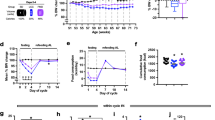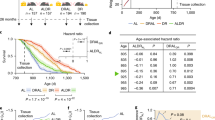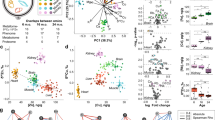Abstract
The age-induced decline in the body's ability to fight disease is exacerbated by obesity and metabolic disease. Using a mouse model of diet-induced obesity, the combined challenge of a high-fat diet and age on liver morphology and biochemistry was characterized, while evaluating the potential of 15 min per day of high frequency (90 Hz), extremely low-magnitude (0.2 G) mechanical signals (LMMS) to suppress lipid accumulation in the liver. Following a 36-week protocol (animals 43 weeks of age), suppression of hepatomegaly and steatosis was reflected by a 29% lower liver mass in LMMS animals as compared with controls. Average triglyceride content was 101.7±19.4 μg mg−1 tissue in the livers of high-fat diet control (HFD) animals, whereas HFD+LMMS animals realized a 27% reduction to 73.8±22.8 μg mg−1 tissue. In HFD+LMMS animals, liver free fatty acids were also reduced to 0.026±0.009 μEq mg−1 tissue from 0.035±0.005 μEq mg−1 tissue in HFD. Moderate to severe micro- and macrovesicular steatosis in HFD was contrasted to a 49% reduction in area covered by the vacuoles of at least 15 μm2 in size in HFD+LMMS animals. These data provide preliminary evidence of the ability of LMMS to attenuate the progression of fatty liver disease, most likely achieved indirectly by suppressing adipogenesis and thus the total adipose burden through life, thereby reducing a downstream challenge to liver morphology and function.
This is a preview of subscription content, access via your institution
Access options
Subscribe to this journal
Receive 12 print issues and online access
$259.00 per year
only $21.58 per issue
Buy this article
- Purchase on Springer Link
- Instant access to full article PDF
Prices may be subject to local taxes which are calculated during checkout


Similar content being viewed by others
References
Duvnjak M, Lerotic I, Barsic N, Tomasić V, Virović Jukić L, Velagić V . Pathogenesis and management issues for non-alcoholic fatty liver disease. World J Gastroenterol 2007; 13: 4539–4550.
Rubin CT, Capilla E, Luu YK, Busa B, Crawford H, Nolan DJ et al. Adipogenesis is inhibited by brief, daily exposure to high-frequency, extremely low-magnitude mechanical signals. Proc Natl Acad Sci USA 2007; 104: 17879–17884.
Luu YK, Capilla E, Rosen CJ, Gilsanz V, Pessin JE, Judex S et al. Mechanical stimulation of mesenchymal stem cell proliferation and differentiation promotes osteogenesis while preventing dietary-induced obesity. J Bone Miner Res 2009; 24: 50–61.
Judex S, Lei X, Han D, Rubin C . Low-magnitude mechanical signals that stimulate bone formation in the ovariectomized rat are dependent on the applied frequency but not on the strain magnitude. J Biomech 2007; 40: 1333–1339.
Rubin CT, Lanyon LE . Dynamic strain similarity in vertebrates; an alternative to allometric limb bone scaling. J Theor Biol 1984; 107: 321–327.
Luu YK, Lublinsky S, Ozcivici E, Capilla E, Pessin JE, Rubin CT et al. In vivo quantification of subcutaneous and visceral adiposity by micro-computed tomography in a small animal model. Med Eng Phys 2009; 31: 34–41.
Huang PL . A comprehensive definition for metabolic syndrome. Dis Model Mech 2009; 2: 231–237.
Fonseca-Alaniz MH, Takada J, Alonso-Vale MI, Lima FB . Adipose tissue as an endocrine organ: from theory to practice. J Pediatr (Rio J) 2007; 83: S192–S203.
Kashyap SR, Diab DL, Baker AR, Yerian L, Bajaj H, Gray-McGuire C et al. Triglyceride levels and not adipokine concentrations are closely related to severity of nonalcoholic fatty liver disease in an obesity surgery cohort. Obesity (Silver Spring) 2009; 17: 1696–1701.
Sen B, Xie Z, Case N, Ma M, Rubin C, Rubin J . Mechanical strain inhibits adipogenesis in mesenchymal stem cells by stimulating a durable β-catenin signal. Endocrinology 2008; 149: 6065–6075.
Frank LL, Sorensen BE, Yasui Y, Tworoger SS, Schwartz RS, Ulrich CM et al. Effects of exercise on metabolic risk variables in overweight postmenopausal women: a randomized clinical trial. Obes Res 2005; 13: 615–625.
Ryan AS . Insulin resistance with aging: effects of diet and exercise. Sports Med 2000; 30: 327–346.
Kris-Etherton PM, Taylor DS, Smiciklas-Wright H, Mitchell DC, Bekhuis TC, Olson BH et al. High-soluble-fiber foods in conjunction with a telephone-based, personalized behavior change support service result in favorable changes in lipids and lifestyles after 7 weeks. J Am Diet Assoc 2002; 102: 503–510.
Mensink M, Blaak EE, Wagenmakers AJ, Saris WH . Lifestyle intervention and fatty acid metabolism in glucose-intolerant subjects. Obes Res 2005; 13: 1354–1362.
Griffin JJ . Handbook of Human Vibration. Academic Press: London, 2001.
International Standards Organization. Evaluation of Human Exposure to Whole-Body Vibration. ISO 2631/1. ISO: Geneva, 1985.
Gilsanz V, Wren TA, Sanchez M, Dorey F, Judex S, Rubin C . Low-level, high-frequency mechanical signals enhance musculoskeletal development of young women with low BMD. J Bone Miner Res 2006; 21: 1464–1474.
Acknowledgements
We thank S Lublinsky for help with animal imaging. This work was supported by the National Institutes of Health Grant AR 43498.
Author information
Authors and Affiliations
Corresponding author
Rights and permissions
About this article
Cite this article
Luu, Y., Ozcivici, E., Capilla, E. et al. Development of diet-induced fatty liver disease in the aging mouse is suppressed by brief daily exposure to low-magnitude mechanical signals. Int J Obes 34, 401–405 (2010). https://doi.org/10.1038/ijo.2009.240
Received:
Revised:
Accepted:
Published:
Issue Date:
DOI: https://doi.org/10.1038/ijo.2009.240
Keywords
This article is cited by
-
Combating osteoporosis and obesity with exercise: leveraging cell mechanosensitivity
Nature Reviews Endocrinology (2019)
-
Recovery of stem cell proliferation by low intensity vibration under simulated microgravity requires LINC complex
npj Microgravity (2019)
-
Multiscale investigation on the effects of additional weight bearing in combination with low-magnitude high-frequency vibration on bone quality of growing female rats
Journal of Bone and Mineral Metabolism (2018)
-
Daily application of low magnitude mechanical stimulus inhibits the growth of MDA-MB-231 breast cancer cells in vitro
Cancer Cell International (2014)



